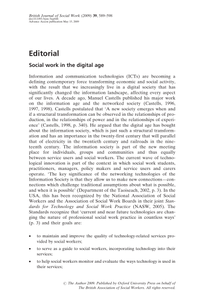Vergelijkende Europese studie in opdracht van Kees van Aken, toenmalig directeur van de opleiding Social Work i.o. van de Hogeschool Zuyd, naar welke verschillende varianten er mogelijk zijn als er gesproken wordt over een Internationale Bachelor Social Work - Maastricht. Op welke manieren zijn er in Europa reeds internationale bachelors zijn ontwikkeld. Het onderzoek moet een overzicht van enkele blauwdrukken van een Internationale Bachelor Social Work opleveren, om mede op basis daarvan een keuze te maken voor een (eventueel meerdere) voor Hogeschool Zuyd wenselijke variant(en) daarvan in Maastricht. Er is vergelijkend Europees onderzoek gedaan naar de verschillende filosofieën en organisatievormen van curricula International Social Work zoals die op verschillende Hogescholen en Universiteiten in Europa functioneren. Met name zijn “good practice” ervaringen onderzocht en met elkaar vergeleken, om op basis daarvan een aantal varianten helder te krijgen voor de opdrachtgever.
DOCUMENT

Column over de vraag: wil het Nederlandse “sociaal werk” nog wel een internationaal perspectief? Onder de titel "Social work in een international perspectief" is deze column uitgesproken tijdens het symposium “Samenleven is geen privézaak” op 29 maart 2012, ter gelegenheid van het afscheid Hans van Ewijk (lector sociale innovatie).
MULTIFILE

This research aims to contribute to a better understanding of strategic collaborations between work-integration social enterprises (WISEs) and for-profit enterprises (FPEs) with the joint objective to improve labour market opportunities for vulnerable groups. We find that most collaborations strive towards integration or transformation in order to make more social impact.
LINK
Although the contribution of social entrepreneurship to social innovation is becoming increasingly acknowledged in theory and practice, it is less apparent in relation to social work. This chapter aims to contribute to a better understanding of social entrepreneurship in relation to issues of social innovation and social work. We will do this by focusing in particular on work integration of vulnerable groups, one of the most dominant impact areas in which many social enterprises are active and which most directly relates to the traditional domain of social work. The chapter analyses specific examples from the UK and the Netherlands to discuss how social enterprises have contributed to systemic change in the social domain, and what its possible implications could be for the future of social work.
LINK
Inleiding op een themanummer van British Journal of Social Work over sociaal werk in de digitale samenleving.
DOCUMENT

Article about social work and social policy in the Netherlands. It gives information about the background, history, the meaning of the profession and the different types of professional areas in which the profession is divided. Other subjects are: social work curricula, the European dimension of social work an current challenges for social professionals in the Netherlands.
DOCUMENT

Article about social work and social policy in the Netherlands. It gives information about the background, history, the meaning of the profession and the different types of professional areas in which the profession is divided. Other subjects are: social work curricula, the European dimension of social work an current challenges for social professionals in the Netherlands.
DOCUMENT

This study examines the motives of employees to engage in workrelated social media use – i.e. the use of personal social mediaaccounts to communicate about work-related issues. The theory ofplanned behavior (TPB) was used to explain this behavior.Because social media can enable users to express theiridentities, social identity expressiveness and self-identityexpressiveness were added to the TPB model. Through an onlinequestionnaire, using purposive sampling technique, 514 Dutchemployees were asked about their social media use and motivationto do so. We used structural equation modelling (SEM) to testour hypotheses. Results indicate that these identity constructsenhance the predictive ability of the TPB. As such, workrelationsocial media use is likely to take place spontaneouslyrather than deliberately and consciously planned.
DOCUMENT
